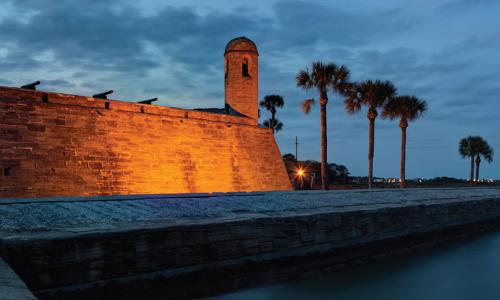This profile is excerpted from the 2014 report, "National Landmarks at Risk: How Rising Seas, Floods, and Wildfires Are Threatening the United States' Most Cherished Historic Sites."
Preserving the past is as much a part of the culture of Charleston as the Spanish moss that drapes from its live oak trees and the ample rain that falls on the South Carolina coast throughout the year. Standing in one of Charleston’s quaint streets, one can imagine being there in the nineteenth century well before the Civil War.
The passion for historic preservation in this colonial-era city took firm hold a century ago, driven by a desire to convey Charleston’s role in the development of the nation. Pioneering laws passed in 1931 to protect the city’s architectural jewels led to the creation of its Old and Historic District—a national landmark that now includes more than 4,800 historic structures—which became a model for cultural stewardship across the country.
But protecting notable buildings from the wrecking ball or the ravages of time may no longer be enough to save some of Charleston’s most treasured resources. The city’s longtime struggle with flooding is expected to worsen over the coming decades as global warming continues to increase the pace of sea level rise and causes the heaviest rainfall events to dump more water than in decades past.
Established in 1670, Charleston soon became a major port, prosperous trading center, and one of the South’s most sophisticated cities. Its architecturally distinct Old Exchange and Provost Dungeon, completed in 1771 as the colony’s cultural center, is South Carolina’s oldest public building.
Charleston’s long military history includes the first naval victory over the British in the War of Independence and the first shots fired by the Confederacy on Union forces at Fort Sumter, thereby sparking the Civil War.
The city is also inextricably tied to the deplorable saga of Southern slavery. The Old Slave Mart Museum, housed in a former slave auction gallery, recalls the harrowing stories of Africans who cultivated plantation crops for long hours under harsh conditions.
Today, nearly 5 million visitors a year flock to Charleston to savor its Southern hospitality; admire picturesque mansions with high ceilings, ornate plaster, and deep verandas; or tour sprawling eighteenth-century plantations along the nearby Ashley River Road National Scenic Byway.
Charleston also attracts much attention for its modern amenities such as restaurants, galleries, and the annual Spoleto Festival USA, which is internationally recognized as one of the premier performing-arts festivals in the United States. According to the College of Charleston’s School of Business, tourism during 2012 pumped more than $3.5 billion into the city’s economy.
But because Charleston is on a harbor off the Atlantic Ocean, is virtually surrounded by water, and lies only a few feet above mean sea level in many places, the city often struggles with flooding—a problem exacerbated by rising sea levels. During simultaneous high tide and heavy rainfall, the stormwater collection system fills with seawater and leaves little room for storm runoff. Even on sunny days, extreme high tides cause saltwater to back up though the storm drains and spill out onto the roads, snarling traffic and sometimes forcing businesses to close. Expensive efforts to build new pumping stations and tunnels are in the works, but the water could still back up whenever the amount of rainfall exceeds the capacity of the new systems.
With air and ocean temperatures on the rise, scientists project that Charleston’s flooding problem will only get worse. Already, an increasing percentage of rain comes from extreme storms, which poses increased risk to infrastructure designed for historic, not current, rain patterns.
Routine summer thunderstorms and high tides regularly flood the popular Historic City Market area, sometimes causing residents and tourists alike to wade through thigh-deep water. The frequency of such “nuisance” flooding is also expected to dramatically increase with rising seas. With a sea level rise of four feet—at the high end of the range of what is likely—the market area will become inundated. A sea level rise of only two feet will inundate historic homes south of Colonial Lake Park.
Hurricanes are a major threat to the area during the summer and early fall. And just as warming ocean waters in the North Atlantic can make hurricanes more intense, the seawater is evaporating into warmer air, which holds more water.
This can make the heaviest rainfall events even heavier than before. Thus with a changing climate, Charleston residents may face more rainfall in the most intense storms, such as Hurricane Hugo. This Category 4 storm, which struck the South Carolina coast in 1989, killed 26 people, affected 85 percent of the city’s properties, and caused more than $6 billion in damage.
Given its growing population and vibrant tourism industry, Charleston will have to be as aggressive in protecting itself from present and future climate change as it has been in preserving the city’s cultural past.




